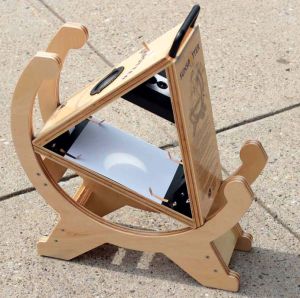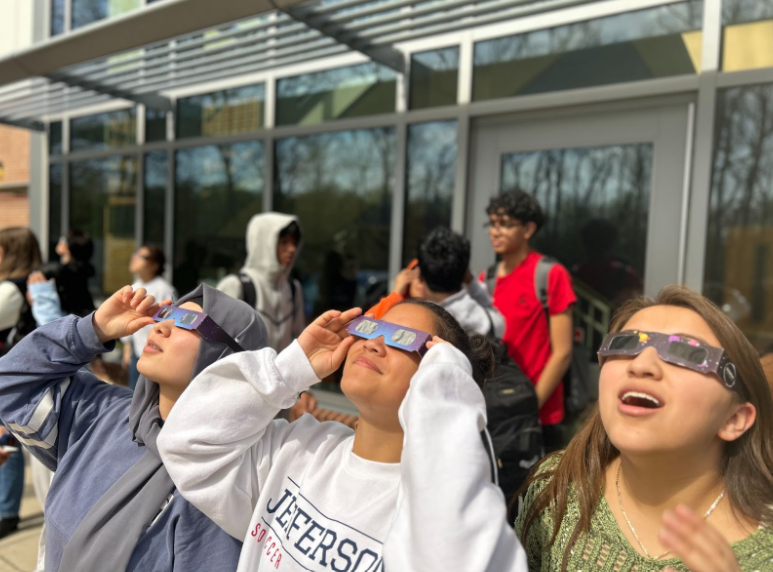A solar eclipse moved across North America on April 8, passing over Mexico, Canada and the United States. A solar eclipse occurs when the moon aligns with the sun, totally or partially obscuring the sky. From Alexandria, Virginia, the moon covered about 87.1% of the sun at the peak of its eclipse. The Physics and Geosystems Department organized a solar eclipse viewing for students and faculty with an extended 8th period B block.
“It started off with the physics department saying, ‘Hey, there’s going to be an eclipse. These are really special and rare; we should do something,’” physics teacher Elissa Levy said. “We reached out to Geosystems and talked about whether we wanted to make pinhole viewers, etc. We brought in our assistant principal, Yaara Crane, who oversees Science and Tech.”
Organizing the event for the whole school required immense effort and time. Jefferson faculty communicated with Fairfax County Public Schools (FCPS) administrators to ensure the event was safe for all students and faculty.
“[In the beginning] FCPS did not allow us to use glasses. We could only see through pinholes, ” Levy said. “We started planning a school-wide [event], and then Ms. Crane took over the logistics. Within a couple of weeks, FCPS changed their minds about the glasses, and Ms. Crane went ahead and got glasses for the entire school.”
Solar eclipse glasses contain a dark film that dims light across all wavelengths for safe viewing of the sun. Jefferson students also had the opportunity to use professional equipment supplied by teachers.
“Dr. William Linch had the solar telescope [with a resolution of] 657 nanometers,” Levy said. “We had a bunch of smaller solar telescopes made out of wood that the Geosystems faculty provided, and I brought some colanders to see the shape of the eclipse through its holes. Ms. [Margarita] Kelly and Dr. [Adam] Smith’s physics and [astronomy] clubs also brought in various pinhole viewing devices.”

Students also used a sunspotter solar telescope, which employs lenses and mirrors to show a projection of a sun’s image.
“The sunspotter is set up like a triangle. Once that light goes through the opening, it hits a series of mirrors that are at each of the corners and then goes through a second lens that will then project the image of the sun with the moon covering it on a piece of paper. You can see sunspots along with it, hence the name sunspotter,” Astronomy and Astrophysics research lab director Stephanie Sarmiento said.
The last time a full solar eclipse passed through North America was 2017 when current Jefferson students were in elementary school. This time around, the eclipse viewing felt more scientific for many students.
“I clearly remember watching the 2017 eclipse but having no clue why it happened. I was just amazed that the sun was disappearing,” junior Nicole Liu said. “When I watched it recently, I fully understood why it happened as well as the science behind the pinhole projections, which made it more unique.”
Jefferson’s equipment made eclipse viewing more accessible, as not all households own glasses or telescopes.
“My parents, who did not have the glasses, blowtorched pieces of glass until they were black and looked through the glass,” Liu said.
Although the next solar eclipse visible from North America will be in 2044, a solar eclipse will pass over parts of the Pacific Ocean and Southern Hemisphere on Oct. 2 later this year. With hundreds of glasses no longer needed by students, Jefferson is distributing the glasses for eclipse viewers in South America.
“There’s a program collecting the glasses to send down to South America for the next eclipse,” Sarmiento said. “They asked for us to return any glasses that were undamaged so that we can ship them.”
Solar eclipses are a rewarding and often nostalgic experience.
“The first solar eclipse I was aware of was when I was in first grade. They put the shades down and we weren’t allowed to look outside,” Levy said. “I remember thinking, ‘This is so unfair.’ I’m really glad that Ms. Crane and all the teachers found a way to [allow] any student who wanted to see [the eclipse] see it, because the next one’s in another 20 years.”


